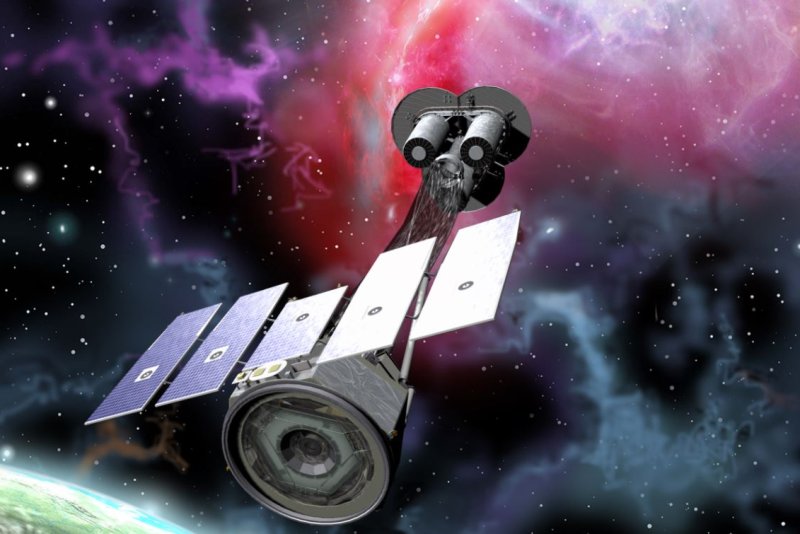SCIENCE NEWS
DEC. 8, 2021

An illustration depicts NASA's IXPE satellite pointed at a nebula in space with three identical X-ray optics imagers at top, sensors at bottom and solar arrays. Image courtesy of NASA
ORLANDO, Fla., Dec. 8 (UPI) -- NASA intends to learn more about stars, neutron stars, black holes, nebulae and other space objects by launching a new X-ray telescope satellite, the IXPE, from Florida early Thursday.
The $214 million IXPE satellite, or X-ray Polarimetry Explorer, will orbit the Earth as the first satellite dedicated to measuring the polarization of X-rays from a variety of cosmic sources, according to NASA.
Such X-rays are invisible waves similar to visible light that can help scientists understand how space objects behave.
Black holes and magnetars -- small collapsed stars that are more magnetic than any other stars in the galaxy -- will be a particular target of the IXPE mission.
DEC. 8, 2021

An illustration depicts NASA's IXPE satellite pointed at a nebula in space with three identical X-ray optics imagers at top, sensors at bottom and solar arrays. Image courtesy of NASA
ORLANDO, Fla., Dec. 8 (UPI) -- NASA intends to learn more about stars, neutron stars, black holes, nebulae and other space objects by launching a new X-ray telescope satellite, the IXPE, from Florida early Thursday.
The $214 million IXPE satellite, or X-ray Polarimetry Explorer, will orbit the Earth as the first satellite dedicated to measuring the polarization of X-rays from a variety of cosmic sources, according to NASA.
Such X-rays are invisible waves similar to visible light that can help scientists understand how space objects behave.
Black holes and magnetars -- small collapsed stars that are more magnetic than any other stars in the galaxy -- will be a particular target of the IXPE mission.

NASA's Imaging X-ray Polarimetry Explorer (IXPE) is prepared for launch at Ball Aerospace in Colorado. Photo courtesy of Ball Aerospace
RELATED Scientists: Next space telescope should exceed James Webb' s ability to study planets
NASA intends to use IXPE to measure the scope of magnetic fields from such objects, and to test how the objects produce such waves, Martin Weisskopf, principal scientist on the mission, said during a press conference Tuesday at Kennedy Space Center in Florida.
"It's a new toolkit for astronomy and astrophysics, and I can't wait to see it work," said Weisskopf, who also is a NASA chief scientist for X-ray astronomy.
NASA intends to use IXPE to measure the scope of magnetic fields from such objects, and to test how the objects produce such waves, Martin Weisskopf, principal scientist on the mission, said during a press conference Tuesday at Kennedy Space Center in Florida.
"It's a new toolkit for astronomy and astrophysics, and I can't wait to see it work," said Weisskopf, who also is a NASA chief scientist for X-ray astronomy.
The astronomy community expects to learn unexpected things about stars, pulsars and black holes, he said.

An illustration depicts NASA's IXPE satellite in space with three identical X-ray optics imagers at top, sensors at bottom and solar arrays. Image courtesy of NASA
RELATED NASA launches climate change-tracking Landsat 9 satellite
"We expect that we'll measure something that no theorist will be able to tell us why we measured it, and that's great. We'll have to modify our expectations," Weisskopf said.
Colorado-based Ball Aerospace built IXPE to expand once it reaches orbit around the Earth, said Makenzie Lystrup, vice president and general manager of civil space at the company.
The observatory has three telescopes to collect X-rays, with sensors connected by a boom and solar arrays for power.
"The mirrors and the instruments have to be about 13 feet apart, but you can't fit that inside a spacecraft [nosecone] and so we built it so ... it compresses down to about only 12 inches during launch," Lystrup said.
SpaceX plans to launch IXPE as early as 1 a.m. EST Thursday, using a SpaceX Falcon 9 rocket, from Complex 39A at NASA's Kennedy Space Center.
The launch will be the company's fifth for NASA's Launch Services Program, following the launch of NASA's DART asteroid deflection mission Nov. 24.
The booster for the launch will be used for a fifth time, following recoveries after NASA's Crew-1 and Crew-2 astronaut missions, SiriusXM satellite SXM-8 launch and CRS-23 cargo launch to the International Space Station.
No comments:
Post a Comment